|
Brigadier General Alfred Jackson v. Colonel William Thomas
| Colonel William Holland Thomas |
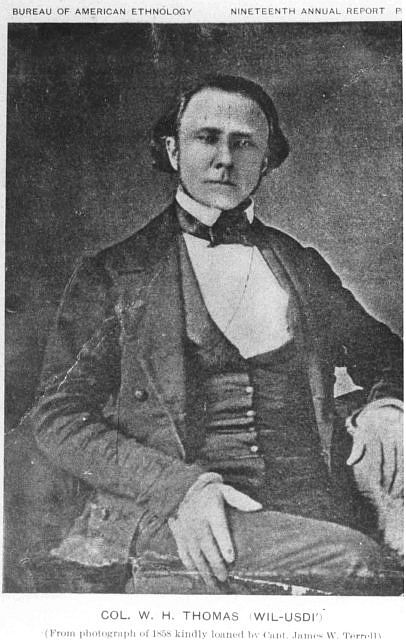
|
| Cherokee Chief and Col. William Holland Thomas |
| General Alfred E. Jackson |
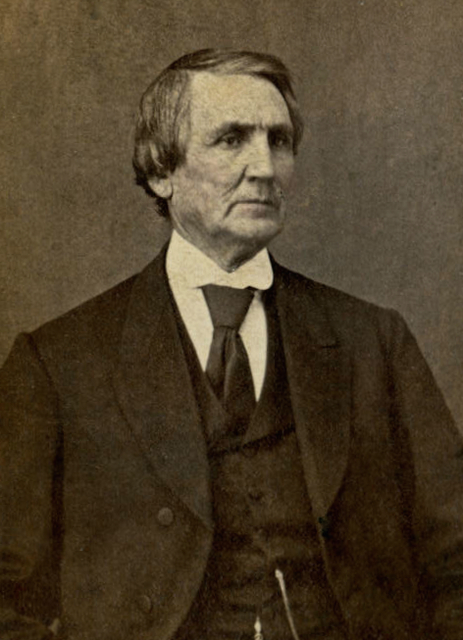
|
| Brig. Gen. Alfred E. Jackson |
Introduction
During the Civil War (1861-1865), whereas William Thomas
would be subjected to three court-martials, Alfred Jackson would be deemed unfit for command.
President
Davis insisted that Thomas' court-martials were "disingenuous and
destructive to the Confederate cause." Related to Thomas by marriage, Davis would not hesitate to countermand each punitive
measure leveled at Thomas, who served in dual capacity as Cherokee chief and Confederate colonel during the conflict. Jackson
meanwhile would be known throughout the Confederacy as "Old Mudwall," a disparaging nom de guerre assigned by
the very men he commanded. Both mountain men were in their mid-50s and neither had served in the military when they answered
the call of the newly formed Confederate States. Financially successful, the self-made men, and former slaveholders, were
citizens of two homogenous mountain regions known as East Tennessee and Western North Carolina. Reminiscent of sibling
rivalry, these two alpha males would become embroiled in a command dispute that would eventually demand intervention
from Richmond, the Rebel capitol that housed none other than Davis, the Confederate President. As the winds of war
gradually ceased, both, now physically and emotionally infirmed and financially in ruins, sought to recover their fortunes
during their twilight years. William Holland Thomas, aged 88, would pass away on May 10, 1893, the exact date that his cousin Davis was captured while fleeing the
Lost Cause in 1865, and the date that "Stonewall" Jackson was accidently shot and mortally wounded by his
own troops in 1863 while at Chancellorsville. Alfred Eugene Jackson would live to be the eldest citizen of his community when, on October 30, 1889, he died at age 82. With merely
an introduction, the sobering facts show that these two Southerners had much more in common than not.

|
| Jackson and Thomas |
Alpha
Males
Two
fifty-something alpha males and just one opening for Confederate commander was the setting that Colonel
William H. Thomas and Brig. Gen. Alfred E. Jackson would contest during the American Civil War, but since neither man
would acquiesce, the fallout would demand a response from Richmond. Prior to the war, Tennessean Alfred Jackson was a slaveholder, prosperous farmer, and rising transportation tycoon but he had never even
donned the military uniform. North Carolinian William Thomas was a boy when he was adopted by the prominent Cherokee Chief
Yonaguska, who would later appoint Thomas, now a self-taught lawyer and Indian Agent to Washington, as successor Chief of
the Eastern Band. His mother would become widow just months prior to the birth of William, and although she was related to President Zachary
Taylor, her son Little Will, as he was known by the Cherokee, would be raised in obscurity. By the 1840s, however, Thomas rose
to prominence while serving as both state senator and Chief of the Oconaluftee, but he too had never served in the military
when he volunteered his services by submitting plans to raise an army that would only be used to defend the Tar
Heel State against any armed incursion by Federal forces.
Command
and Control
Although Thomas' uncompromising
Civil War strategy
would be the basis for his many court-martials, the colonel enjoyed a unique status with President Jefferson Davis, because through his Strother lineage he
was cousin to Sarah Knox Taylor, the daughter of President Zachary Taylor, and
she was married Davis until her untimely death caused by malaria.
In the summer of 1863,
while assigned to Jackson's brigade, Thomas was arrested and awaiting court-martial. Whereas Thomas' Legion had been reorganized into Jackson's
Brigade, the command generally consisted of Thomas'
Legion only. (O.R., Series 1, Volume 29, pt. II, p. 812, O.R., 31, 1, p. 454, and O.R., Series 1, Vol. 33, p. 1137). Was it a legion but brigade in name only, as some of the legion would argue. Why was the legion taken from
Thomas and then veiled as a brigade under Jackson. This confusing command structure was highly contested, so Jackson had Thomas
arrested in June of 1863 and charged with "disobedience of orders." Thomas was sent
to Knoxville to await trial, but Union General Burnside's East Tennessee invasion intervened thus postponing the trial.
Inept decisions by headquarters
with the problematic command structure would chip away at the unit's morale and even lead to desertion, and while Richmond
vacillated on taking any action on the subject, its generals would have the audacity to complain about the appearance and thinning
ranks of this so-called brigade, but meanwhile, the soldiers of the legion were vacating their muster station in East
Tennessee and returning to North Carolina where they would serve and defend the home front. By the summer of 1864,
orders were at last issued for the infantry regiment, of the Thomas' Legion, moving it into the action of the Shenandoah Valley
before reassigning it to Thomas, who would remain in North Carolina with his Cherokee Battalion.
| Jackson and Thomas |
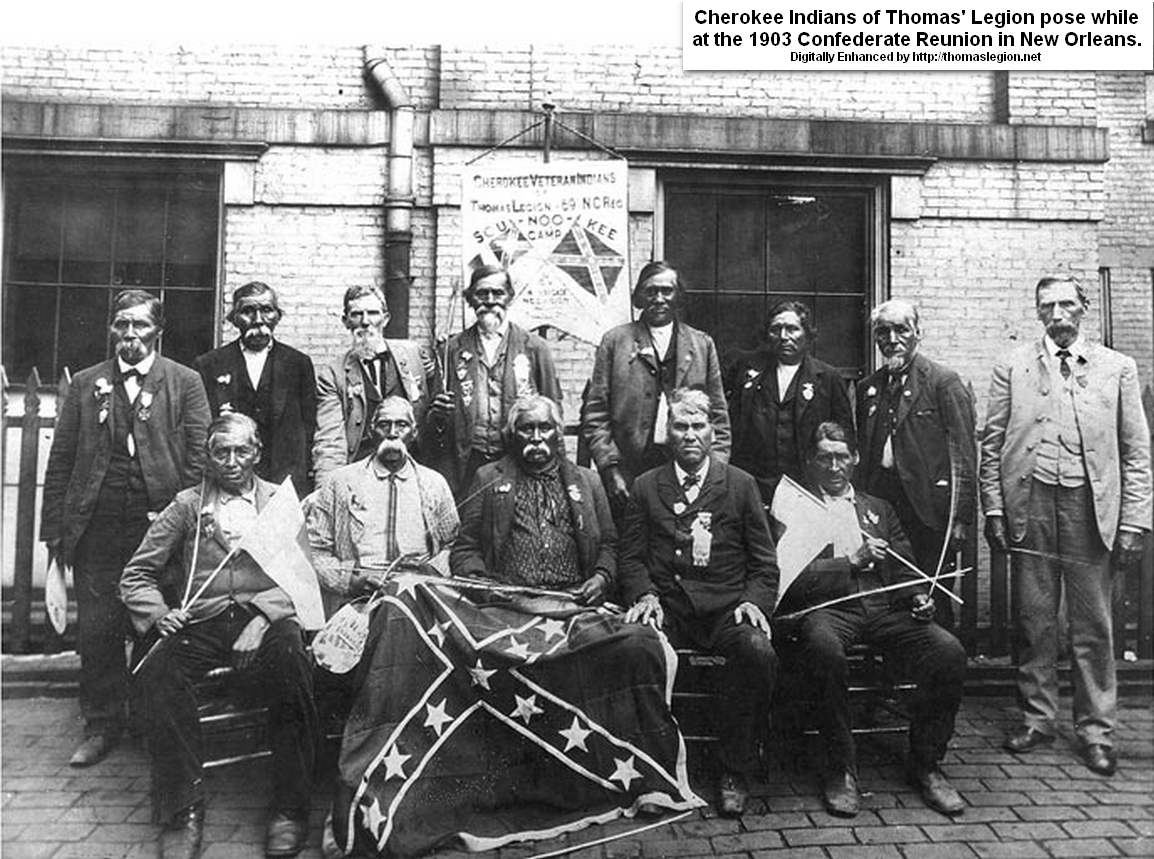
|
| Some Cherokee Indians who served under both Jackson and Thomas |
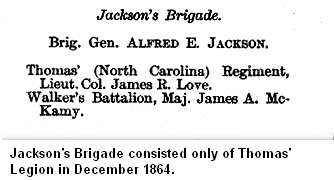
|
| Brig. Gen. Alfred Jackson's Brigade |
Continuing Conflict
Prior to the Civil War, Thomas and the prominent Vance
family of North Carolina were often on opposing sides of legislation, and while they espoused dissimilar views on subjects
ranging from the ad valorem tax to senate railroad bills, the conflicting political positions would merely carry over and
become more intense during the stresses of war.
Another court-martial for Thomas was to occur on February
23, 1864, because of the capture of Brig. Gen. Robert B. Vance, brother to Governor Zebulon Vance. Leaving Colonel Thomas at Gatlinburg,
Tennessee, Gen. Vance had proceeded to Sevierville and was captured because he failed to post pickets and not as a result
of Thomas disobeying orders. Although Vance would remain in a Federal prison until the war ended, he
would later concede that his capture was a misunderstanding of orders.
Concerning the capture of Brig. Gen. Vance, Colonel John
B. Palmer stated that Lt. Col. James L. Henry, and not Thomas, should be
court-martialed. (O.R., Ser. 1, Vol. 32, pt. 1, p. 76). Confederate Secretary of War James Seddon believed that Vance was partially
responsible for his own capture, and President Davis, receiving updates on the subject, wrote that "no
action is practicable which seems proper." (O.R., 32, 1, p. 77). On behalf of Thomas, Davis intervened and having the charges dismissed,
there would be no trial.
Official records and reports also show that Thomas was not responsible
for the capture of Robert Vance, but the governor insisted otherwise, stating that there was culpability while referencing Thomas,
and he was determined to use his brother's capture as an opportunity to punish his nemesis. Zeb Vance would serve as
North Carolina's Governor for much of the war (1862-1865 and 1876-1878) and later in the U.S. Senate (1879-1894), making him
one of the most prominent political figures in the history of the Old North State.
On May 11, 1864, Thomas was charged with receiving and adding
to his unit some deserters from the 65th North Carolina between September
1863 and April 1864, but on this occasion, General Jackson was relieved of his command for health reasons and reassigned
to the Army of Tennessee, and Thomas appeared to have avoided another court-martial. In October 1864, the trial resumed
and Thomas was indeed found guilty of all charges. This court-martial had
combined a prior court-martial with four additional charges, but the colonel responded the way he had to previous
charges when he appealed to Davis, who merely reversed the charges.
"Old Mudwall" Jackson would
be assigned to staff duty on November 23, 1864, and serve the remainder of the war without a command. But the Thomas Legion
saw its infantry regiment detached and assigned to Jubal Early's Army of the Valley during the summer of 1864,
where it fought many battles with large Union armies, before it was ordered back to North Carolina and reassigned to
Thomas who had been commanding the Cherokee Battalion and involved in few pitched battles but many skirmishes with guerrillas
and bushwhackers.
| East Tennessee Railroads during the Civil War |
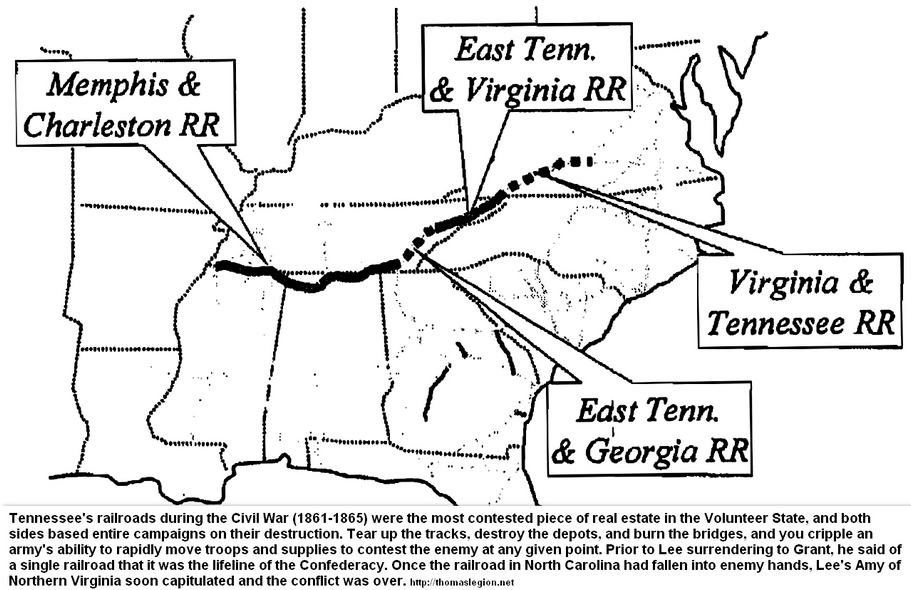
|
| Jackson's Brigade was tasked with defending the sole railroad in East Tennessee |
(About) In East Tennessee there was a single railroad that
meant the difference in transporting men and equipment between the theaters of the war -- and it had to be defending
at all hazards. Involved in transportation and understanding the importance of logistics, Brig. Gen. Alfred Jackson, with
scare resources, gave great efforts in defense of the region's railroads. In the theater of the brigadier's operations
there was a good deal of detachment work in which there was plenty of marching and fighting, but very little chance
for renown, because the great battles of the war so obscured the small affairs that in many parts of the country they were
never even heard of.
Brigade or Legion
There are just a few documents showing "Thomas’ regiment, North Carolina"
or "Thomas’ regiment, North Carolina Volunteers," and though Jackson's Brigade is discussed below as it appeared
on one occasion, April 20, 1864, notice at the bottom of the page that the Official Records of the Union and Confederate
Armies adds a footnote and records that the units forming Brig. Gen. Jackson's command were "otherwise known as the Thomas
(North Carolina) Legion."
While Levi’s (Virginia) artillery battery is mentioned it was,
however, also part of the Thomas legion, and on this occasion Burroughs’ and McClung’s Tennessee batteries
were temporarily assigned to the organization, but Jackson's Brigade was generally composed only of elements of
the Thomas Legion.
The Official Records answer
the age old question whether the command was a brigade or a legion. The stated footnote does indicated that it was indeed
a legion, but made to appear as a brigade. The units that formed Jackson's Brigade were "otherwise known as the Thomas
(North Carolina) Legion." Lt. Col. William W. Stringfield, Thomas' Legion, said that “it appears that Jackson
broke up the Legion in order to make it a brigade and call it his Brigade.”
When viewing the components of the brigade, it included all the
components of Thomas' Legion, and only Thomas' Legion, but Jackson couldn't use the word legion when referring to
any portion of the command, because then the brigade itself would no longer exist. (See also Thomas' Regiment in O.R., Series 1, Volume 33, p. 1137.) The following has been transcribed from Official Records of the Union and Confederate Armies, Series 1,
Vol. 32, Part III, 802, with original text, spelling, and footnotes.
| Official Records |

|
| Jackson's Brigade and Thomas' Legion |
Organization of Buckner’s Division, Brig. Gen. Bushrod
R. Johnson, C. S. Army, commanding, April 20, 1864.•
Jackson’s Brigade.
Brig. Gen. Alfred E. Jackson.
Thomas’
regiment,++ Lieut. Col. James R. Love.
Walker’s battalion,++ Lieut. Col. James A. Mckamy.
Levi’s (Virginia)
battery.
Burroughs’ (Tennessee) battery.
McClung’s (Tennessee) battery.
Johnson’s Brigade.
Col. John S. Fulton.
17th Tennessee, Col. R. H. Keeble.
23rd Tennessee, Col. R. H. Keeble.
25th Tennessee, Lieut.
Col. John L. McEwen, jr.
44th Tennessee, Lieut. Col. John L. McEwen, jr.
63d Tennessee, Col. Abraham Folkerson.
Detachments,
+ Capt. Nathan Dodd.
Gracie’s Brigade
Brig. Gen. Archibald Gracie, Jr.
41st Alabama, Col. Martin L. Stansel.
43rd
Alabama, Lieut. Col. John J. Jolly.
59th Alabama, Col. Bolling Hall, jr.
60th Alabama, Maj. Hatch Cook.
23rd Alabama,
Battalion Sharpshooters, Maj. Nicholas Stallworth.
++ Otherwise known as the Thomas (North Carolina) Legion
+ From
the Sixteenth Georgia Battalion and the Third, Thirty-first, Forty-third, Sixtieth, Sixty-first, and Sixty-second Tennessee
Regiments.
• As shown by inspection reports of Lieu. Col. Archer Anderson, assistant adjutant-general. Jackson’s
brigade at Carter’s Depot, the others near Zollicoffer.
| Thomas Legion |
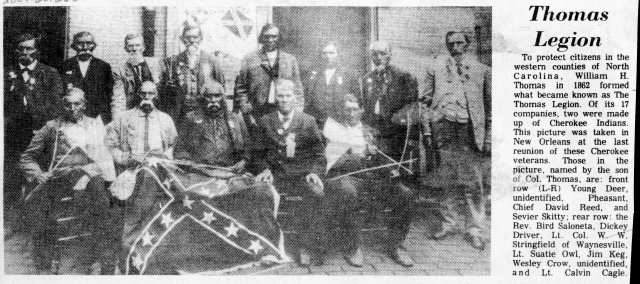
|
| Cherokee Representation at 1903 Confederate Reunion in New Orleans |
(Additional sources and related reading below.)
Recommended Reading:
East Tennessee and the Civil War (Hardcover: 588 pages). Description: A solid social, political, and military history, this work gives
light to the rise of the pro-Union and pro-Confederacy factions. It explores the political developments and recounts in fine
detail the military maneuvering and conflicts that occurred. Beginning with a history of the state's first settlers, the author
lays a strong foundation for understanding the values and beliefs of East Tennesseans. He examines the rise of abolition and secession, and then advances into
the Civil War. Continued below...
Early in the
conflict, Union sympathizers burned a number of railroad bridges, resulting in occupation by Confederate troops and abuses
upon the Unionists and their families. The author also documents in detail the ‘siege and relief’ of Knoxville.
Although authored by a Unionist, the work is objective in nature and fair in its treatment of the South and the Confederate
cause, and, complete with a comprehensive index, this work should be in every Civil War library.
Recommended
Reading: Storm in the Mountains: Thomas' Confederate Legion of Cherokee Indians and Mountaineers (Thomas' Legion:
The Sixty-ninth North Carolina Regiment). Description: Vernon H. Crow, Storm in
the Mountains, spent 10 years conducting extensive Thomas Legion's research. Crow was granted access to rare
manuscripts, special collections, and privately held diaries which add great depth to this rarely discussed Civil War
legion. He explores and discusses the unit's formation, fighting history, and life of the legion's commander--Cherokee
chief and Confederate colonel--William Holland Thomas. Continued below...
Numerous maps
and photographs allow the reader to better understand and relate to the subjects discussed. It also contains rosters
which is an added bonus for researchers and genealogists. Crow, furthermore, left no stone unturned while examining the
many facets of the Thomas Legion and his research is conveyed on a level that scores with Civil War students and scholars
alike.
Recommended
Reading: North Carolina Troops, 1861-1865: A Roster (Volume XVI: Thomas's Legion) (Hardcover) (537 pages), North Carolina Office
of Archives and History (June 26, 2008). Description: The volume begins with an authoritative 246-page history of Thomas's Legion.
The history, including Civil War battles and campaigns, is followed by a complete roster and service records of the field
officers, staff, and troops that served in the legion. A thorough index completes the volume. Continued below...
Volume XVI
of North Carolina Troops: A Roster contains the history and roster of the most unusual North Carolina Confederate Civil
War unit, significant because of the large number of Cherokee Indians who served in its ranks. Thomas's Legion was the creation
of William Holland Thomas, an influential businessman, state legislator, and Cherokee chief. He initially raised a small
battalion of Cherokees in April 1862, and gradually expanded his command with companies of white soldiers raised in western
North Carolina,
eastern Tennessee, and Virginia.
By the end of 1862, Thomas's Legion comprised an infantry regiment and a battalion of infantry and cavalry. An artillery battery
was added in April 1863. Furthermore, in General Early's Army of the Valley, the Thomas Legion was well-known for its fighting
prowess. It is also known for its pivotal role in the last Civil War battle east of the Mississippi
River. The Thomas Legion mustered more than 2,500 soldiers and it closely resembled a brigade. With troop roster, muster records, and Compiled Military Service Records (CMSR) this volume
is also a must have for anyone interested in genealogy and researching Civil War ancestors. Simply stated, it is an outstanding
source for genealogists.
Recommended Reading:
Generals in Gray Lives of the Confederate Commanders. Description: When Generals in Gray was published in 1959, scholars
and critics immediately hailed it as one of the few indispensable books on the American Civil War. Historian Stanley Horn,
for example, wrote, "It is difficult for a reviewer to restrain his enthusiasm in recommending a monumental book of this high
quality and value." Here at last is the paperback edition of Ezra J. Warner’s magnum opus with its concise, detailed
biographical sketches and—in an amazing feat of research—photographs of all 425 Confederate generals. Continued
below...
The only exhaustive guide to the South’s command,
Generals in Gray belongs on the shelf of anyone interested in the Civil War. RATED 5 STARS!
Recommended Reading: Bushwhackers, The Civil War in North Carolina: The
Mountains (338 pages). Description: Trotter's
book (which could have been titled "Murder, Mayhem, and Mountain Madness") is an epic backdrop for the most horrific
murdering, plundering and pillaging of the mountain communities of western North Carolina during the state’s darkest
hour—the American Civil War. Commonly referred to as Southern Appalachia, the North Carolina
and East Tennessee mountains witnessed divided loyalties in its bushwhackers and guerrilla
units. These so-called “bushwhackers” even used the conflict to settle old feuds and scores, which, in some cases,
continued well after the war ended. Continued below...
Some bushwhackers were highly organized ‘fighting
guerrilla units’ while others were a motley group of deserters and outliers, and, since most of them were residents
of the region, they were familiar with the terrain and made for a “very formidable foe.” In this work, Trotter
does a great job on covering the many facets of the bushwhackers, including their: battles, skirmishes, raids, activities,
motives, the outcome, and even the aftermath. This book is also a great source for tracing ancestors during the Civil War;
a must have for the family researcher of Southern Appalachia. "[T]he historical events that transpired in the region are brought to life in this
study."
Sources: Official Records of the Union and Confederate Armies; Walter Clark, Histories
of the Several Regiments and Battalions from North Carolina in the Great War 1861-1865; National Park Service: American Civil
War; National Park Service: Soldiers and Sailors System; Weymouth T. Jordan and Louis H. Manarin, North Carolina Troops, 1861-1865; D. H. Hill, Confederate Military History Of North Carolina: North Carolina
In The Civil War, 1861-1865; Vernon H. Crow, Storm in the Mountains: Thomas' Confederate Legion of Cherokee Indians and Mountaineers;
Vernon H. Crow, The Justness of Our Cause; E. Stanly Godbolt, Jr. and Mattie U. Russell, Confederate Colonel and Cherokee
Chief: The Life of William Holland Thomas; The Civil War Diary of William W. Stringfield, Johnson City, TN: East Tennessee
Historical Society Publications; and John R. Finger, The Eastern Band of Cherokees.
|

